
The 2018 Novichok affair poisoned relations not only between Russia and Britain, but also more widely between western governments and Moscow. The international response to the British claims resulted in greatly reduced diplomatic engagement.
Others have highlighted the many absurditities of the official narrative and the clear incompleteness of the official evidence for it. And I’ve previously covered the later events in Amesbury that were to be linked to the Skripal affair.
This article puts forward an account that attempts to reconcile evidence the Skripals were treated for a fentanyl/opioid overdose with subsequent official findings, that biomedical samples indicated exposure to a nerve agent. It is somewhat narrowly focused, avoiding other questions as to who first poisoned the pair, or for what motive.
For some time I had wondered how the OPCW found indications of nerve agent in the biomedical samples, when the reports and testimony suggested the pair had been exposed to fentanyl. I now think I can see how this could have happened.
What follows is intended as schematic, and as a starting point for further enquiry from a non-expert perspective, rather than as a definitive account.
After briefly presenting the evidence that the Skripals’ medical emergency was indeed due to fentanyl, or a similar opioid analgesic, and not a nerve agent; I’ll outline how, in principle, biomedical samples indicating nerve agent exposure could be consistent with medical treatment for an overdose of an opioid analgesic. Such a scenario is consistent both with the reporting and official statements concerning not only the Skripals, but also the other purported Wiltshire Novichok victims. Available evidence supports their treatment plans being contrived and adapted, with the desired biomedical results in mind.
First things first – that they did not fall ill due to poisoning with a nerve agent
Initial reports indicated they were treated for fentanyl overdose.
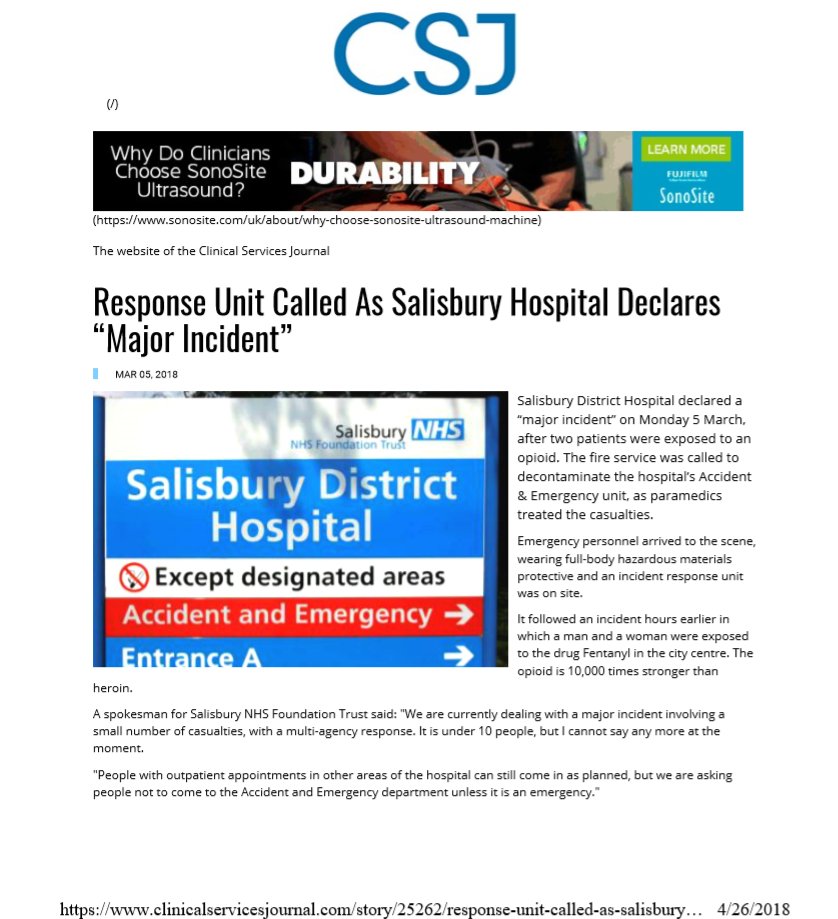
- Paramedic responding to Salisbury drama thought drugs were cause, Salisbury Journal, March 15, 2018
-
- A PARAMEDIC who was among the first to respond to
Sergei Skripal and his daughter told the Prime Minister they had
initially treated the pair for drugs. … The man, named Ian, said he
had been in the first ambulance service response car on the scene. Mrs
May asked him: “At that stage you could only treat for what you can
see?” Salisbury MP John Glen interjected to say he had heard initial
reports the incident was drug-related. To which the paramedic replied:
“Absolutely that’s what I was treating for, that’s what we treated them
for initially.”
- A PARAMEDIC who was among the first to respond to
That the initial assessment and treatment was for such an overdose, was corroborated by later testimony by a ward sister at the hospital who told BBC Newsnight that there was no mention of nerve agent in the original assessment and treatment of the pair. This was the case for at least 36 hours.
Other media reports in the days following discounted nerve agent exposure. The Daily Mirror reported a source from DSTL:
Scientists at the secret lab, which has state-of-the-art equipment to look for trace amounts of substances, have reportedly ruled out nuclear material or a nerve agent in preliminary toxicology tests...
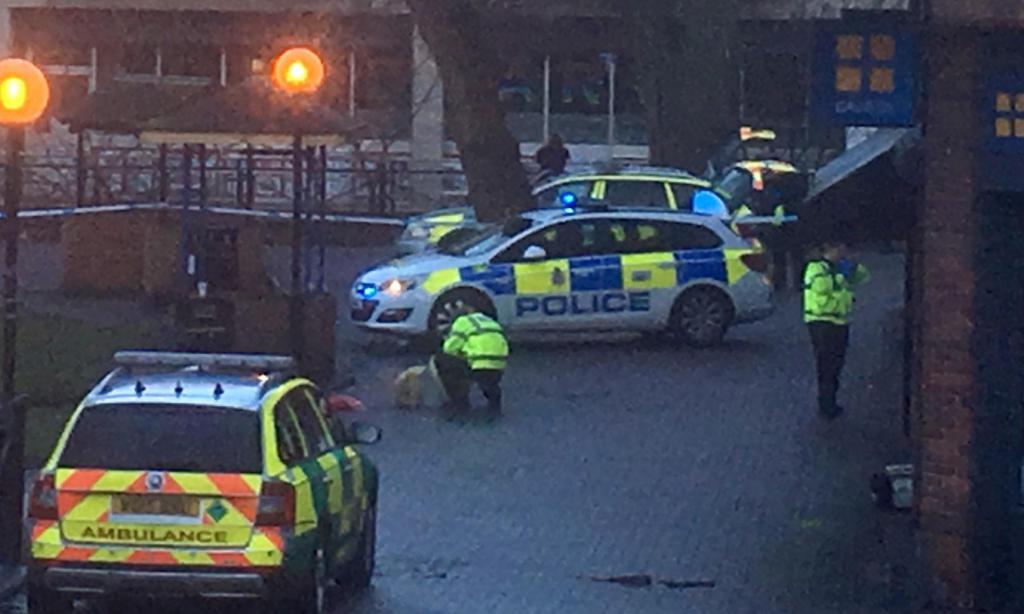
Despite:
- the first responders, – including, apparently the CBRN trained Chief Nursing Office of the British army – who attended the Skripals not noting signs of nerve agent
- or being affected themselves by nerve agent exposure
- and DSTL having previously ruled out nerve agent
- and Police and Public Health England both assuring no risk to public
- and hospital staff not considering nerve agent poisoning during the first 36 hours, but treating for opioid overdose. (The details of blood tests taken by the hospital in this period are unaccounted for)
It was subsequently announced by Her Majesty’s Government that the Skripals were poisoned by Novichok which was, they said, a very deadly and uniquely Russian nerve agent…
So what would have happened at the Hospital? And how could OPCW biomedical samples indicate exposure to a nerve agent?
Weeks after being discharged from hospital, and in an appearance staged under the control of security services, Yulia had a visible scar on her throat. This was most probably from her having been intubated due to respiratory depression, the primary symptom of opioid analgesic overdose.
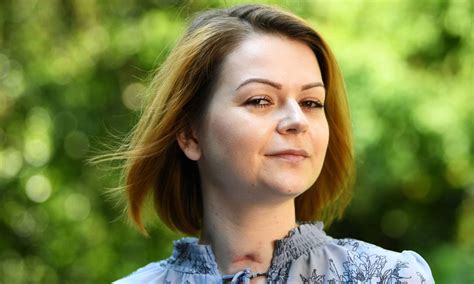
Fig: Decision Tree for Managing Opioid analgesic Overdose in adults
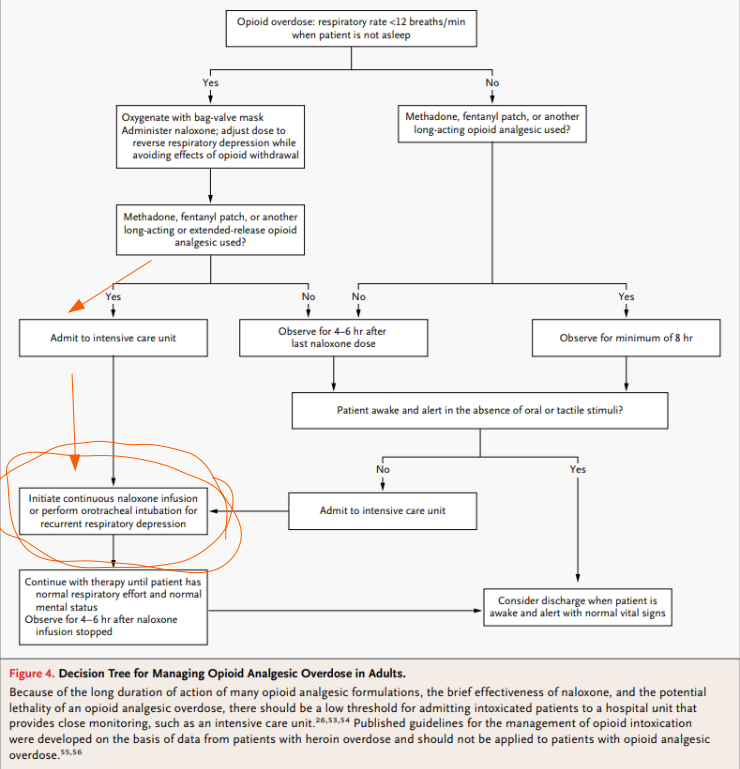
The standard response to fentanyl overdose is use of naloxone. It is likely, then, that the first line of treatment by a paramedic, and then in hospital would be naloxone injections. Which are a relatively simple procedure. Naloxone kits are now even distributed to families of addicts

But the Skripal’s case was clearly not an ordinary one, concerning people with substance abuse problems. The pair’s identity becoming known was to greatly impact the hospital’s management of the case. Here is a summary of events at the hospital.
When the Skripals were found, an opioid overdose was suspected…
“The evening that Yulia and Sergei were admitted, at that point we were led to believe that they have taken an overdose, so there was no mention of nerve agent poisoning,” … ward sister in charge of the shift on March 4, told BBC2’s Newsnight in an interview broadcast on Tuesday. “They were needing their support with their breathing and support with their cardiovascular system.”
“At first, when they first came in, there was no indication of the fact that it was a nerve agent. And therefore, we take our normal protection when any patient comes in but would have not at that point taken any extra precaution in terms of protecting ourselves,” ..
But by the Tuesday morning the management of the case had drastically changed. The London’s Counter Terror Policing Network (CTPN) had taken over the investigation. Police Officer Nick Bailey presented to the Hospital and specialists from Defence Science and Technology Laboratory (DTSL) at Porton Down began to ‘advise’ the medics.
From that point on, doctors at Salisbury Hospital began to administer medical treatment, the details of which are kept secret due to medical “confidentiality” concerns. The hospital continued to receive advice from international experts, including the Porton Down chemical weapons research laboratory.
“Clinical decisions were ours, but we would be foolish not to take their advice, which we did. And I think that helped,” intensive care consultant Dr. Jukes noted. “When we began seeing some improvements, it happened a lot quicker than anticipated. Certainly, when you look at these groups of nerve agents, the expectations from the textbooks, the journals suggested a much longer period of recovery.”
The pair had been put into induced comas.
Anticholinergic syndrome would be among the effects of a fentanyl overdose. In general, the symptoms of opioid intoxication and nerve agents are dissimilar, with somewhat opposite actions. But cholinergic symptomology quite similar to that of nerve agent exposure can be caused by opioid reversal, such as that produced by naloxone’s opioid receptor antagonism. Naloxone treatment causes ‘precipitated opioid withdrawal‘ which is said to be intensely painful and disorientating.
Precipitated opioid withdrawal is characterised by the rapid onset of opioid withdrawal symptoms (such as aches, nausea and vomiting, diarrhoea and abdominal cramps, dilated pupils, running nose, yawning) …
It can, then, be clinically necessary to mitigate the rapid loss of analgesia caused by opioid reversal.
Moreover naloxone may be only briefly effective against long acting opioid analgesics. The effects of certain fentanyl analogues like carfentanil are said to be even less responsive to naloxone treatment.
But other ‘respiratory stimulants’ can be used to reverse opioid intoxication. One such agent is physostigimine – considered a “a safe antidote to treat anticholinergic overdose”.
Physostigmine is classed as a ‘reversible cholinesterase inhibitor’. While nerve agents are ‘irreversible cholinesterase inhibitors’.
Although it’s a standard drug that a hospital would have in its inventory, phsyostigimine also happens to be well known in the field of chemical warfare. So it is possible that once Porton Down’s experts began ‘advising’ medics, this drug was employed instead of naloxone.
Its use would, also, cause symptoms of precipitated opioid withdrawal. So it would be considered desirable to combine it with something to attenuate the intense withdrawal symptoms.
Combining use of the physostigimine as a respiratory stimulant, with the irreversible cholinesterase inhibitor diisopropylflourophosphate (DFP) – a weakly toxic analogue of sarin – appears to be a way for the ‘experts’ to kill two birds with one stone, three birds even.
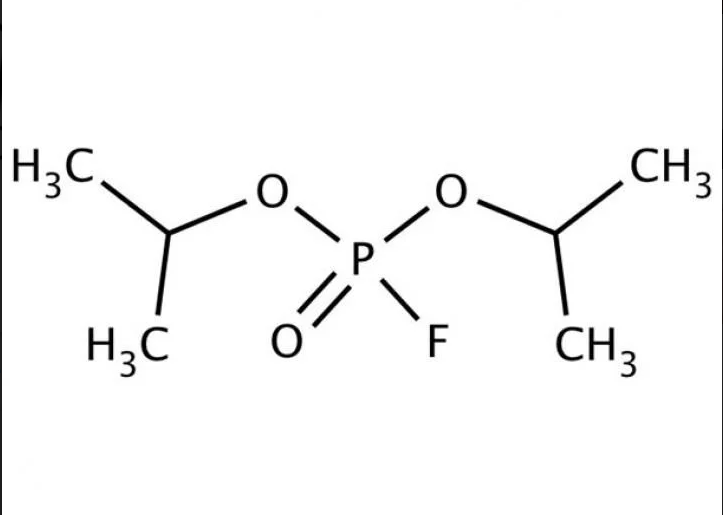
DFP has an analgesic effect that would attenuate the symptoms of withdrawal produced by physostigimine’s opioid receptor antagonism.
The hospital would likely also have DFP available in its inventory. It can be used in eyedrops to treat miosis or glaucoma.
It happens that physostigimine is known to have a prophylactic effect against exposure to the ‘irreversible’ effects of nerve agents, including DFP. It is often used in experiments for this prophylactic effect.
Using the two agents in combination would be a method to pull the patients out of the symptoms of opioid analgesic intoxication, with the DFP and physostigimine mutually mitigating one another’s adverse effects.
Use of DFP could then leave biomarkers consistent with nerve agent exposure in the samples taken by the OPCW. I suspect this, or something along quite similar lines, is the explanation of how OPCW found signs of a “toxic chemical that displays the properties of a nerve agent” in samples taken in a public hospital setting.
Given that the government was making great play internationally of the poisoning, it seems the advisers from Porton Down devised a treatment plan to suggest to the hospital doctors that would leave biomedical traces consistent with exposure to nerve agent. So I suggest that after abandoning naloxone, such a combination of physostigimine and DFP was used to treat the Skripals’ opioid analgesic intoxication.
The summaries made public by the OPCW of the closed reports don’t say anything about novichoks, but only a “toxic chemical that displays the properties of a nerve agent”. This was said to be the same agent indicated by biomedical samples taken from Dawn Sturgess and Charlie Rowley. This implies that Amesbury pair also received a similar treatment plan, once the management of that case was also taken over by CTPN and DSTL.
As the UK requested that the OPCW reports be kept closed, we do not have the details of the test results. That this secrecy was requested would tend to imply that the results were only weakly supportive of the Novichok claims. Why request secrecy if they had stronger confirmation of the claims, given the intense international scrutiny?
Testing for biomarkers of organophosphate nerve agents can leave considerable indeterminacy. As the agents bind to the enzymes, and are often quickly metabolised in the body. The testing processes often can’t necessarily exclude exposure to another chemical substance with structural similarities.
It seems likely that Nick Bailey was really a volunteer, ‘dummy’ patient sent to the hospital by the British secret services in order to corroborate the Government’s narrative of the use of a Russian chemical weapon on the streets of a sleepy English Cathedral city.

Perhaps he did receive opioids during his two weeks in hospital, used to manage the discomfort, alongside a physostigimine/DFP type combination. If he was treated with such a managed combination of mutually mitigating drugs, it would cause little harm, but would leave the required traces to support the security agencies desired narrative. Like Charlie Rowley he seemed to make a full physical recovery
He later said on TV
“… The drugs I was put on at the hospital had side effects as well and it’s quite difficult to differentiate between the Novichok and the drugs I was on. I had hallucinations and vomiting. It was terrifying.
Such symptoms could be consistent with the cholinergic effects of physostigimine.
Coda

The account given here would imply that when the OPCW team visited Salisbury to take environmental samples, they were guided by British officials to ‘hot spots’ where evidence of ‘Novichok’ had been planted.
Specific criticism of this outline is welcome in the comments. I take what I have presented above to be a plausible and logically based account of what might have happened consistent with the publicly available evidence.
As against a strange tale of a delayed action rare Russian nerve agent in a perfume bottle, smeared on a door handle, by conspicuous and unprofessional seeming agents – quite a comedic sounding assassination plot.
